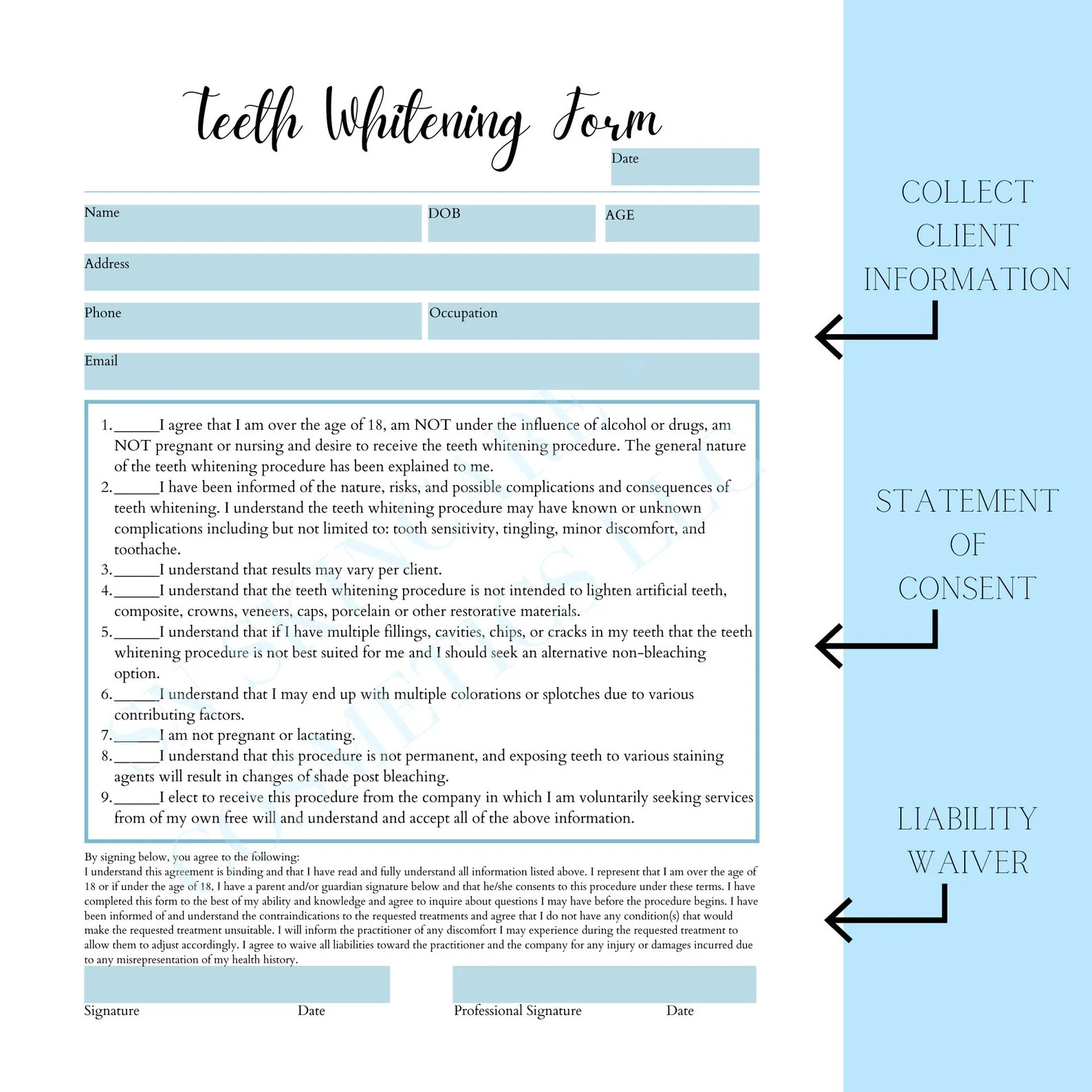What is a Teeth Whitening Consent Form
A teeth whitening consent form is a crucial document used in dental practices and cosmetic dentistry clinics. It serves as a written agreement between the patient and the dental professional, outlining the details of the teeth whitening procedure. This form is essential because it ensures that patients are fully informed about the treatment, its potential benefits, risks, and any alternatives. It protects both the patient and the practitioner by documenting the patient’s understanding and consent to the procedure. This document is a vital aspect of ethical dental practice and helps establish a transparent and trusting relationship between the patient and the dental professional. It is a critical component of informed consent, ensuring that patients make decisions based on a thorough understanding of the treatment they are about to undergo.
Importance of a Consent Form
The significance of a consent form extends beyond mere paperwork. It’s a cornerstone of ethical and legal practice within the dental field. Properly executed consent forms provide clarity and transparency, mitigating potential misunderstandings or disputes. These forms document the patient’s voluntary agreement to undergo a specific treatment after being fully informed about all aspects of the procedure. The consent form acts as a critical tool for legal and ethical protection, it ensures that patients are well-informed and actively involved in decisions about their dental health. It is an integral part of patient care, fostering trust and professionalism in the practice.
Legal Protection for Practitioners
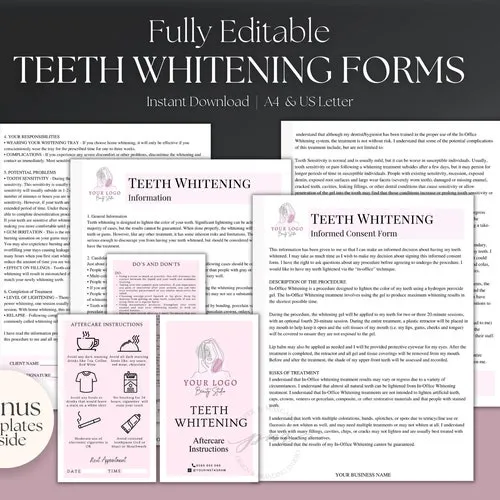
From a legal perspective, a signed consent form offers substantial protection to the dental practitioner. It serves as evidence that the patient was informed about the procedure, its potential risks, and expected outcomes before consenting to the treatment. In case of any unforeseen complications or dissatisfaction, the consent form can be a critical piece of evidence in a legal setting, demonstrating that the practitioner fulfilled their duty to provide sufficient information and obtain the patient’s informed consent. This document is a valuable defense against potential malpractice claims or legal challenges, highlighting the importance of thorough documentation and patient education within the practice.
Protecting the Patient
A consent form primarily safeguards the patient’s rights by ensuring they are fully aware of what they are agreeing to. It guarantees that the patient is informed about all aspects of the teeth whitening procedure, including the expected results, the possibility of side effects, and any available alternative treatments. The process encourages patients to ask questions and make informed choices about their dental health. It allows the patient to make a reasoned decision based on comprehensive information, promoting patient autonomy and shared decision-making. This approach builds trust and strengthens the patient-practitioner relationship, improving overall care and satisfaction.
Elements to Include in a Teeth Whitening Consent Form
Patient Information Section
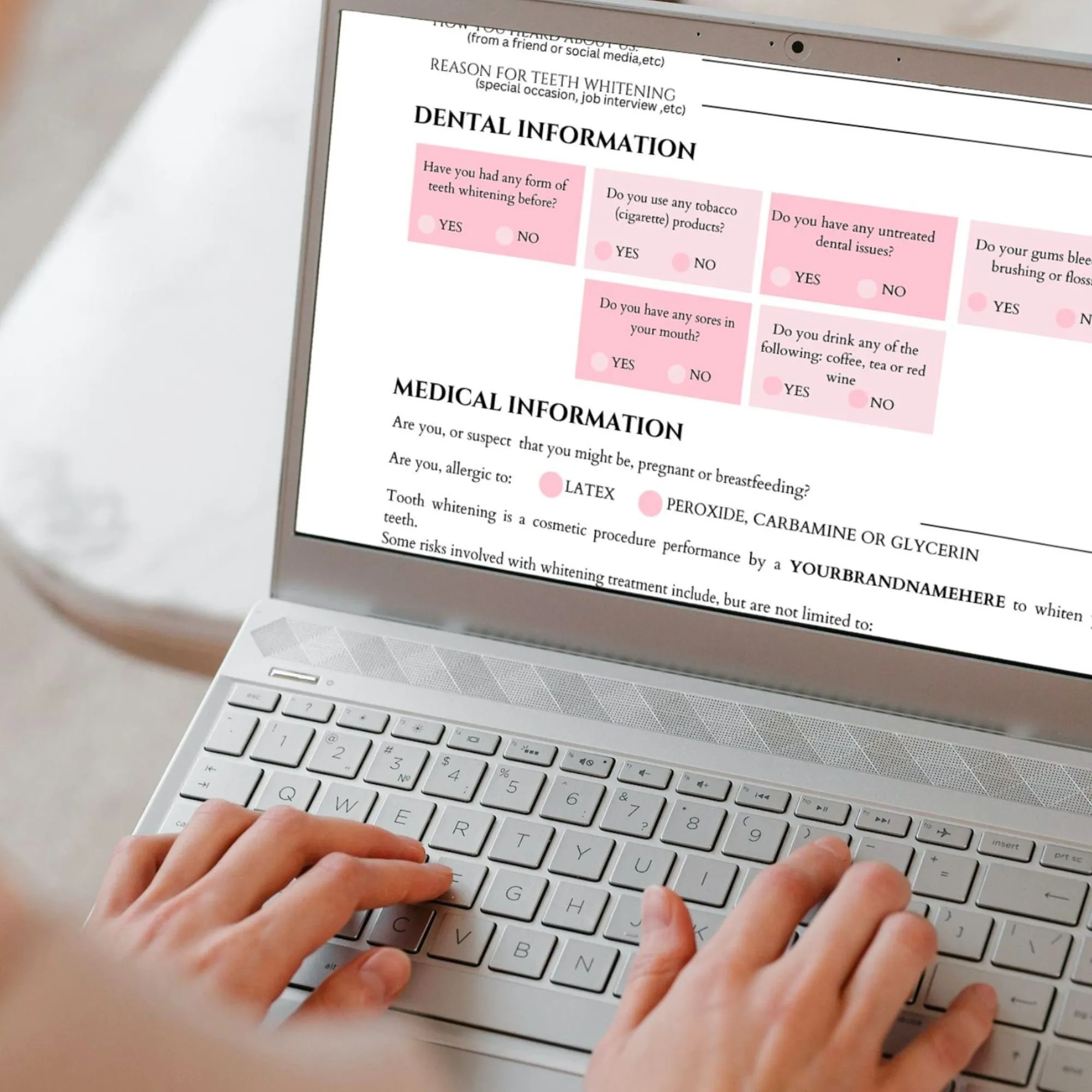
The patient information section is a fundamental component of the consent form, requiring comprehensive details about the patient. This includes the patient’s full name, date of birth, contact information, and any relevant medical history. This information ensures that the practitioner can accurately identify the patient and keep a record of their treatment. It also allows the dentist to assess any potential risks associated with the patient’s medical background. This information is kept private to safeguard the patient’s confidentiality and is crucial for clear communication and accurate record-keeping throughout the teeth whitening process.
Procedure Description
The procedure description is a detailed explanation of the teeth whitening process. It should clearly outline each step, from the initial examination and preparation to the application of the whitening agent and any follow-up care required. The description must be easy to understand, avoiding technical jargon, and should include information on how the process works, how long it will take, and what the patient can expect during the procedure. Visual aids, such as diagrams or illustrations, can be helpful in providing clarity and ensuring that patients have a complete understanding of the treatment.
Risks and Complications
This section is crucial for detailing potential risks and complications associated with teeth whitening. It should include possible side effects like tooth sensitivity, gum irritation, and any other adverse reactions that may occur during or after the procedure. The information should be presented in a balanced and objective manner, clearly stating the likelihood of each risk and how to address them. Providing this comprehensive information is essential to fulfill the requirements of informed consent, enabling patients to make informed decisions about their care. It allows patients to be aware of the various challenges and complications associated with this procedure.
Alternatives to Teeth Whitening
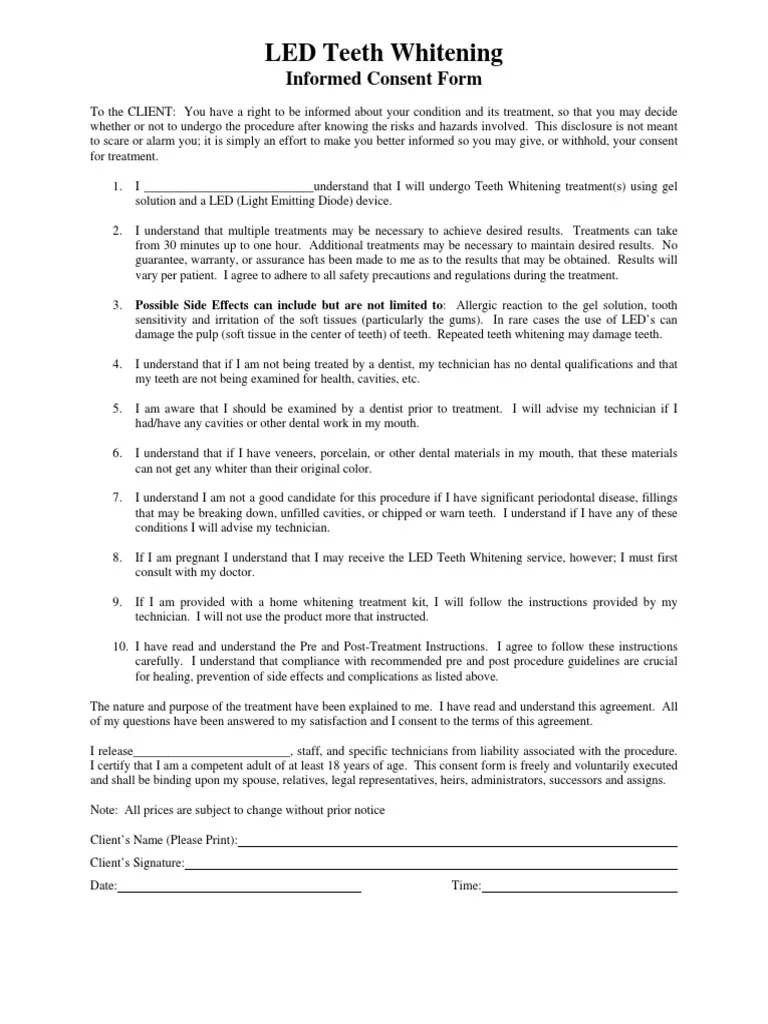
The alternatives section of the consent form offers valuable information about different options available to the patient. It should describe alternatives to teeth whitening, such as professional cleaning, veneers, or other cosmetic procedures, and discuss their respective advantages and disadvantages. The goal is to empower patients to make an informed choice about the best approach for their dental needs. By providing alternatives, the practitioner shows commitment to providing holistic care and gives patients the autonomy to explore all possible treatment paths, so that they can make the best possible choice for their needs.
Patient Agreement and Signature
This is the concluding part of the consent form where the patient formally agrees to undergo the teeth whitening procedure. It includes a clear statement confirming that the patient has read, understood, and agreed to the terms outlined in the form. The patient is required to sign and date the document, and the dental professional or a designated staff member should also sign to confirm that the patient’s consent was obtained. The signature section is the essential part of the consent form, legally validating the agreement and recording the patient’s voluntary decision to proceed with the treatment. It’s a formal acknowledgement of the patient’s informed consent and signifies the commencement of the agreed-upon treatment.
Where to Find a Free Teeth Whitening Consent Form
Online Templates and Websites
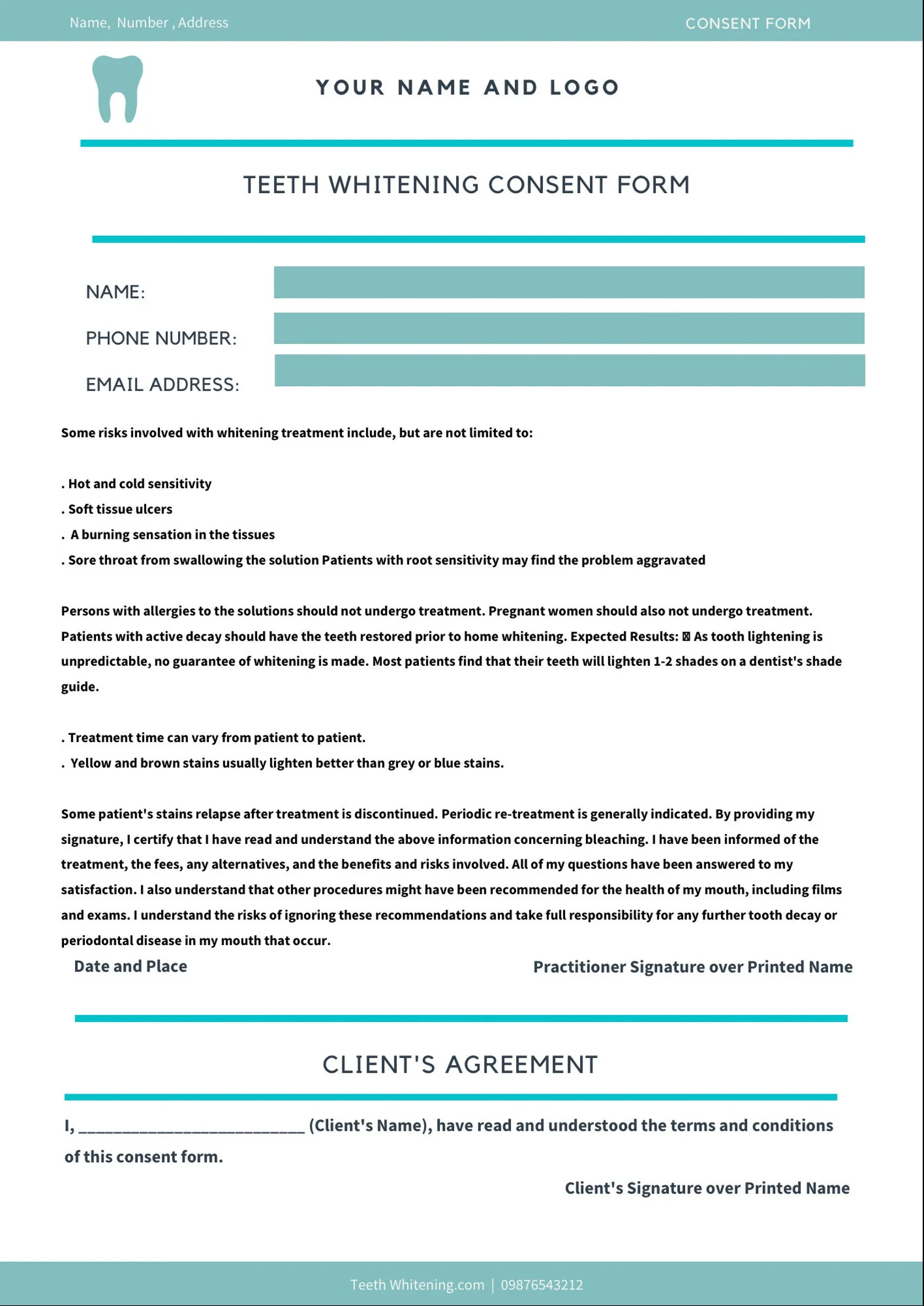
Several websites offer free consent form templates that can be adapted for teeth whitening procedures. These templates are usually available in various formats, such as Word documents or PDFs, making them easy to download and modify. A thorough search online will yield resources from legal firms, dental supply companies, and other related entities. When using an online template, it’s important to carefully review the content and ensure that it includes all the necessary elements relevant to your practice and local regulations. Always double-check to make sure the document is in alignment with professional standards and legal requirements to guarantee your patients protection, and your practice.
Dental Associations and Organizations
Professional dental associations and organizations frequently offer resources and templates, including consent forms, to their members. These resources are often designed to meet current best practices and legal standards, making them a reliable option. Consider exploring the websites of local or national dental associations, as they usually provide valuable information. These organizations also provide updates to ensure the compliance of the latest professional standards and legal regulations, protecting practitioners and patients. As a member, you could access these resources.
Customizing Your Free Consent Form
Adding Your Practice Information
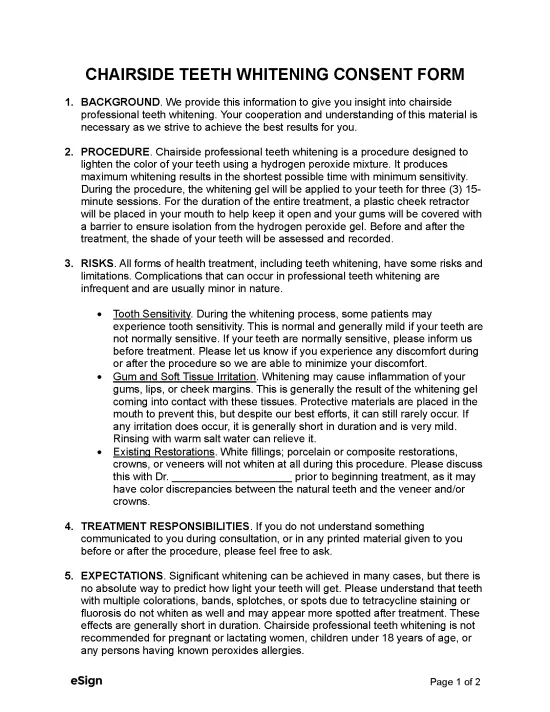
Customizing your consent form is important to fit your practice’s specific needs. Start by including your practice’s name, address, contact details, and logo at the top of the document. This reinforces your brand and ensures that the form is immediately identifiable as belonging to your clinic. Add any special instructions, specific disclaimers, or particular information pertinent to your practice. By including these specific elements, you can create a document that is tailored for your patient base and procedures, enhancing its usefulness and effectiveness.
Reviewing and Updating Regularly
Regulations, industry standards, and best practices for consent forms are always evolving. It is therefore critical to regularly review and update your consent form to maintain accuracy and compliance. Schedule periodic evaluations, at least annually, and whenever there are changes in laws or professional guidelines. Consult with a legal professional to ensure that your form meets the latest standards and protects both your practice and your patients. It is essential to keep your consent forms current to ensure both legal compliance and patient safety and protection.
Best Practices for Using Your Teeth Whitening Consent Form
Explaining the Form Clearly
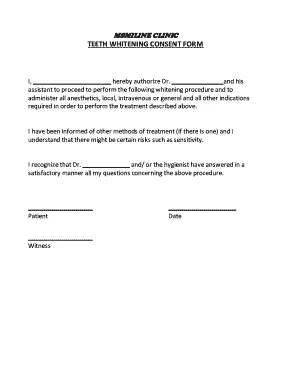
When presenting the consent form to a patient, it is essential to explain it in a simple, easy-to-understand manner. Avoid using complex dental or legal jargon that may confuse the patient. Walk the patient through each section of the form, ensuring they comprehend the procedure description, potential risks, alternative options, and any other important details. Encourage patients to ask questions and provide clear, concise answers to alleviate any uncertainties. This ensures that the patient is fully informed and comfortable with the upcoming treatment, promoting trust and confidence in your practice.
Obtaining Informed Consent
Obtaining informed consent is not just about getting a signature, but about having a conversation with your patient. Ensure that the patient has had ample time to read the consent form and ask questions. Create a comfortable and non-pressured environment where patients feel free to express concerns or uncertainties. Provide patients with clear and honest answers to their questions, addressing any fears or doubts they may have. Only after the patient has expressed a complete understanding of the procedure and its implications should they sign the form. This emphasizes the importance of building trust and shared understanding, which is critical for a successful procedure.
Storing Consent Forms Securely
Protect patient confidentiality and comply with data privacy laws by securely storing all consent forms. Forms must be kept in a safe, locked location, whether in a physical or digital format. Make sure your digital records are protected by strong passwords and encryption. Access to these forms should be limited to authorized personnel only, in order to prevent unauthorized access. Regularly review your data storage practices to ensure that they align with the current privacy regulations and best practices. Secure storage protects patient data, and maintains compliance with legal and ethical standards.
Conclusion
Obtaining a free teeth whitening consent form is the first step, but understanding its significance and using it correctly is even more important. By fully informing your patients and protecting your practice, you can promote ethical dentistry. Follow all the best practices and customize the form to meet your requirements, as this ensures better patient care and compliance with the standards in the dental field.
